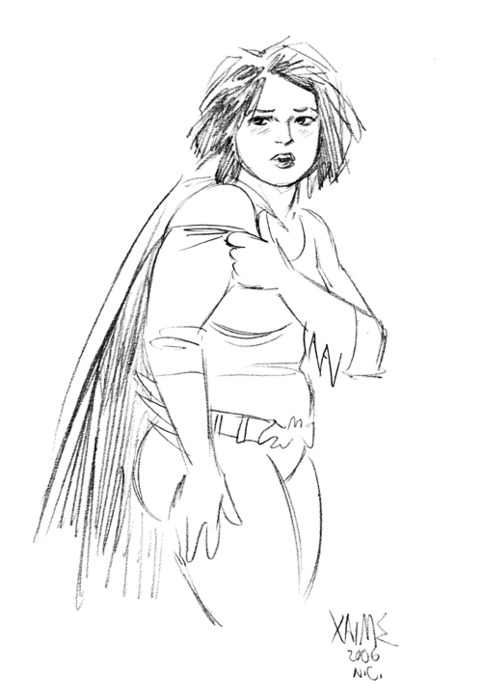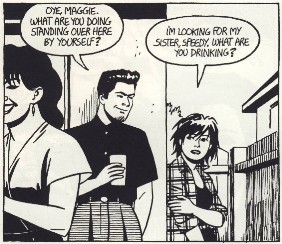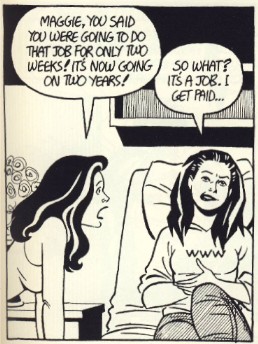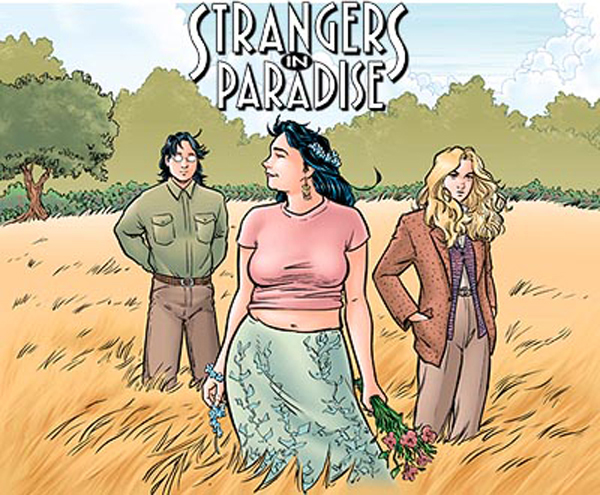
(Convention sketch by Jaime Hernandez from Batgirl, Heck Yeah!)
Despite being one of my favorite comics artists, I’ve always found it hard to write about Jaime Hernandez’s work. I have managed to take both a micro (one page)[1] and a macro (the whole Locas series) approach, so this time I thought I’d try to address a single story. But as I read and thought about it, I again found it difficult to address a single story without moving out to the series as a whole. Thus, I offer these thoughts that came from reading “La Maggie La Loca” and “Gold Diggers of 1969” as found in Love & Rockets v.2 n.20 (Summer 2007)[2].
“La Maggie” originally appeared in the New York Times Sunday Magazine as a weekly serial (the second of their “Funny Pages” comics). It is hard to imagine how a new reader would approach this story. Hernandez drops in information for the new reader, but also leaves much unexplained (who is this “Hopey” on the phone who is mentioned so casually then never heard from again). He seems to be attempting to reach both the new and the long time reader (appropriate for the context), but I wonder how effective, in the end, this can be. Does, as the story progresses, Maggie’s inability to communicate with Rena or the fact of her 40th birthday and the corresponding feelings of aging and failure mean anything to someone who hasn’t been following the character’s life story as found in the rest of the series? As a standalone story, the emotions seem a little unearned without the stories that precede it (which can be both a strength and weakness throughout the series).
As I thought about the new reader and how one would fill in the details for him/her, it brought me back to oft-repeated comments about trying to explain a single superhero comic to someone, and how there is so often such a built up accretion of material that the story (a single issue of a comic book) cannot be appreciated as a individual narrative (for example, I think here of the Chris Claremont written Uncanny X-men stories that were one of the first comics series I read as a kid). This made me realize that despite its longstanding place as a key “alternative” comic to the “mainstream,”[3] Hernandez’s work shares so many components with those mainstream superhero books, perhaps more than it shares with the modern “graphic novel,” placing the Locas stories in middle ground between the two. In one of my previous posts on Locas I wrote: “For someone who is so clearly influenced by and still interested in superheroes, his work is a kind of diametric opposite to the ageless superheroes.” But now I find myself rethinking that statement from my 2008 self. There are many ways Locas is the opposite of the superhero genre, but the two also share a number of elements.
Perhaps this is an obvious revelation, as Hernandez has never totally left behind superheroes. Since its science fiction origins, the series has made use of superheroes in varying diegetic levels (sometimes as part of world of the characters, sometimes as part of those character’s reading material (we know Maggie and Ray both read comics)). As recently as Love & Rockets: New Stories issues 1 and 2 (coincidentally, the comics that immediately followed the revised version of “La Maggie”), Hernandez featured a superhero story (a recent low point of the series). Even disregarding said superhero appearances, the connections are numerous once I started in that direction.
On thinking it, I realized how much the Locas stories probably do fill a similar place for me as superhero comics do for a lot of comics readers. In his post last week, Noah noted “the years and years of investment in the characters, by both the author and his readers.” The reader of Locas, especially the longtime reader, is invested in the characters, much in the same way a longtime reader of a superhero comic is invested in the character(s). And not just the character, but the diegetic world itself, the world that is just this side of the real world (a little further away for the superhero comics, though not by much when taking Locas as a whole). As so many of the recent reviews and comments on “Love Bunglers” have shown, readers have an emotional investment with the characters (especially Maggie, the protagonist).
This connection (and others below) are, admittedly, as much about serialized narrative, as they are about superheroes as a genre, but in comics this type of narrative is more associated with superheroes than any other genre (at least in the present day). In these narratives there is no overarching theme/plot (unlike a traditional novel) beyond the lives of the protagonists. The (seemingly) endless serialized narrative can be found in comics since fairly early on in the history of comic strips (Gasoline Alley to name one), but has since become the province of the “mainstream.” While the comic strips were a daily serialization, made of small pieces strung together, work like superhero comics and Locas are series of longer, slightly more independent stories. Similar to many superhero comics, Locas’ serialization tends to be short narratives with the occasional, multi-part, “to be continued” limited series mixed in. Locas has even had one spin-off series, Whoa Nellie, not unlike a mini-series spin-off from a superhero series.
We can also posit “guest stars” in Locas. The appearance of Rena and Tse Tse in “La Maggie” acts much like a guest appearance in a superhero comic: a character from some previous story returns, offering the “in the know” reader an extra level of engagement with the story. This sense of the reader’s experience with the world of the narrative is an important part of superhero comics and is a primary factor in Locas (again, Noah, did some of the work for me in addressing this issue, though I am more positive on it than he).
Locas even has a few of its own “origin stories.” A case in point (and one I just noticed this time around) is the “Gold Diggers of 1969” strip that runs below “La Maggie” in Love & Rockets v.2 n.20. While the story, drawn in Hernandez’s Dennis the Menace/Little Archie style, shows a very young Maggie as she meets elements of the adult world she doesn’t yet understand (like hiding from bill collectors), the experienced re-reader discovers that the story also contains the birth of Maggie’s brother Calvin, who features so prominently in Love & Rockets: New Stories no.3 and no.4 (2010-2011). The work tends to encourage rereading as a way to better extract the clues from the latter stories as the world and characters are built up.
When we take this road, it’s not hard to see Maggie as the superhero (she is the real protagonist of the series) with a few sidekicks over the years (Hopey early on, Ray, and even, shortly, like the Robin that just didn’t stick, Viviane). Like many superhero protagonists, we have seen her past revisited and rewritten. Hernandez doesn’t explicitly change Maggie’s past, but he does return to the past quite frequently (which Marc just addressed yesterday), adding in narrative information. “Gold Diggers of 1969” does that with another element of Maggie’s childhood, including the birth of Calvin. Further in the past, the story about Maggie’s marriage rewrote/added to elements of the characters’ past as a way to build on the present.
From an industrial standpoint there are also certain similarities of production. Love & Rockets has had a few relaunches (volume 2 and now “New Stories”), with format changes and new number ones. There were even the years of retitling (Penny Century in Locas’ case). Collections of softcovers and hardcovers and deluxe hardcovers and new softcovers are also not dissimilar to the way superhero comics are published. These are pretty much just part of the industry, an increasing (over the course of Locas) shift between the “direct market” and the (non-comic) bookstore market.
Of course, there are also many ways that Locas differs from the superhero genre, foremost being the lack of emphasis on violence and crime as well as the way time works. In Locas time exists both for the world and the characters. Superheroes never really age, time never really moves forward for them, despite the world they exist in changing with the times. Maggie and her world do move forward, characters change and age, as evidenced again in “La Maggie” where the narrative revolves (in retrospect) around Maggie’s 40th birthday (do superheroes ever have birthdays?). This changes the way the reader interacts with the characters. Superheroes are essentially static, and reading them is revisiting endless static variations of the character. The reader of Locas is always faced with the changes of time, the past in the present and the present in the past. Hernandez explicitly pushes this point throughout the series, taking, to stick with our story of focus, as an example the way he reprinted “La Maggie” with a strip beneath it featuring Maggie as a child. The recent “Browntown”/”Love Bunglers”/”Return for Me” stories also push this point with heavy use of analepses in the narrative (again see Marc’s post from yesterday)[4] .
And while superhero comics (for the most part) tend to have changing creators working on a corporate property, Locas is just one artist who owns his characters and stories. Though, Hernandez never seems to remain completely static, if the reader is not seeing an actual change of writer or artist, the long time reader does become attuned to Hernandez’s stylistic evolution and narrative experiments. Which also brings us back to “La Maggie.”
“La Maggie” differs from other Locas stories in a few immediately obvious and other not so obvious ways. It is, as far as I am aware, the first page-by-page serialization in the series. Reading this in a collection, this is most noticeable in elements of the page layout–the colored caption that starts each page as well as the signature that ends each page–but also in the narrative structure. The page as a narrative unit and the repetition of broader narrative moments in the text.
Less obviously different, is the use of narration. In many decades of stories, Hernandez uses narration only in specific contexts. The primary one is through the character Ray Dominguez. Ray’s stories tend to be narration heavy. The reader learns a lot about Ray through his first person narration. This creates a rather different relationship with the character for the readers. Ray tends to be more transparent as a character (we know what’s he thinking and feeling), which is a change from both Maggie and Hopey who remain more opaque. We have to infer their feelings and thoughts based on their actions, spoken words, and the way Hernandez visualizes the stories. The narration in “La Maggie” doesn’t totally break from this tradition, as it reads like a letter to a friend rather than an internal monologue (as Ray’s narration does), and, in that way, it recalls the first time Maggie met Rena in the first story from Love & Rockets v. 1. Like many other aspects of this story, it seems to be another callback for the long time reader, because as far as I can find (skimming all the collections) there’s only one other, very short, story where Maggie narrates (“Angelitas” from v.1 n.45) (In the comments below, Marc Sobel corrected me, noting that “Angelitas” is actually narrated by Maggie’s sister, Esther. Some poor skimming on my part.). So in a way it is another mark of the continuity of the series, and the calls back to the past.
So, having made this comparison, what can I draw from it? As I noted above, by looking at Locas as a superhero, a.k.a. “mainstream”, we see how this bastion of the “alternative” comic is not all that different from the mainstream in many ways. The stories in volume 1 of Love & Rockets especially go through a process of evolution, starting from the “mainstream” and moving into the “alternative,” as Hernandez (mostly) leaves behind the sci-fi/superhero elements that are so prominent in the beginning. What is interesting to consider is how much the “alternative” has moved past this model into a place where Locas can’t go: the stand-alone lengthy narrative (a true “graphic novel” if that term weren’t such a misnomer in most its usage). The literary graphic novel that has risen in the decades since Love & Rockets started has become a whole other type of comic, leaving Locas as an anomaly in many ways, standing beside the superhero comics as one of the last (along with Archie[5]) of the endless comic book serializations[6].
(Addendum: This essay came as a surprise to me when I sat down to rightwrite about Locas, so I’m sure it is rife with propositions that should have been thought through much more thoroughly and carefully, but thus is the way of writing with a deadline.)
_____________
The index to the Locas Stories roundtable is here.
_____________
[1] Also some here and here.
[2] The former, but not the latter, is also found in The Art of Jaime Hernandez by Todd Hignite (Abrams, 2010). I’ll refer to the former as “La Maggie” from here on in to save space.
[3] I have to put these in quotes, because I find the terms so annoying, despite being hard to avoid.
[4] It’s nice how some of the previous roundtable participants are helping me save time by addressing some of the parts I didn’t fill out as I drafted this post.
[5] Archie might on the surface be a better comparison than superheroes. I’m having trouble coming up with any other examples. All the big serialized narratives from the 80’s-90’s that I recall are now completed or gone, and most/all of the completed ones were more directly novelistic than Locas is.
[6] I say “comic book” because I’m not knowledgable enough on the mainstream/popular side of manga/bande dessinee/etc. to comment on the existent of these types of narratives. I think some parallels might be made with bd album series that are, in a way, the bd version of superheroes (ie long running popular genre serializations).





